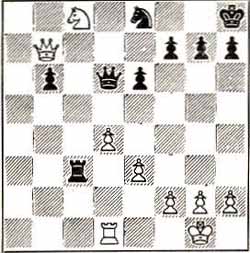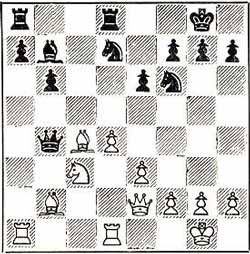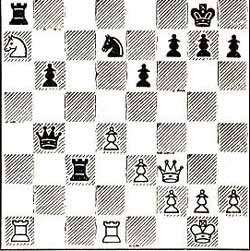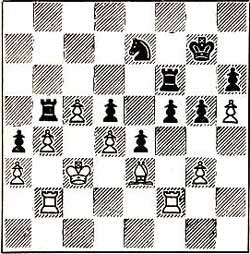|
R A D I O M A T C H R E V I E W E D
|
||
2. MY GAMES WITH RAGOZIN by Herbert Seidman CHESS REVIEW MARCH 1946 |
27. . . . Q-R6?
Hallucinations! Until the moment my hand quitted the piece,
I thought fate was at last smiling on me - changing a bad game to a good
one. 28 Q-Q7! . . . . The end of that dream! If 28 NxP??, R-B8; 29 R-BI, Q-R8; or 28 QxBP, RxN,or 28 P-R3 (P-N3 is answered in thee same way), P-QN4. 28. . . . Q-B1 If 28 ... N-B3; 29 Q-Q8ch, N-Nl: 30 NQ5, P-R3! 31 P-R3! should win without difficulty.
29 Q-Q8 P-N3 At last!
30 . . . . K-N2 If 32 P-N3, N-B2 can be played. If 32 QxN?, R-B8; 33 R-Bl, , RxRch with a perpetual check. 32. . . . R-B8
32... N-B2 may offer more hope since the following
exchanges lead to a fairly definite win for White. However, with two
minutes left on my clock.
33 RxR QxRch
Adjourned after thirteen hours or play. 36 K-N3 P-B3 I resume play, not exactly refreshed after two hours traveling, eight hours work and no sleep!
37 K-B3 K-B2
Very poor. A better fight might be made with ... K-Q3 and ... K-B3. though the game is lost with any defense. 41 K-Q3 N-N4 I intended N-Q8 but then noticed that after 42 P-B3 the Knight would be trapped.
42 P-B3 N-Q3 Passive resistance is equally futile.
44 K-N4 P-N4 Else ....P-N5 might be annoying.
45
. . . .
N-B2
My last hope had been to exchange the Knight Pawn,
sacrifice the Knight for a center Pawn in the event of a Pawn exchange in
that region, and win the remaining Pawn with my King, After the text,
there is no hope at all. |
|
|
1 P-Q4
N-KB3 Black's most promising line against 4 P-K3. 5 N-K2
B-N2 6 ... B-K2 is preferable. The text aids White's development and concedes the two Bishops. There is, however, some counterplay. 7 NxB P-Q4 Aimed against 8 P-B3 followed eventually by P-K4 (building a strong center): and also to preserve the Bishop's influence on the diagonal. 8 B-K2 . . . . Preferable to 8 B-Q3 because it preserves the possibility of fighting for the long diagonal with B-B3. 8. . . .
O-O White welcomes Pawn exchanges, because opening up the position will favor the Bishops. He thus anticipates the inevitable ... P-B4, without which Black's game would be lifeless. 10 . . . . PxP The immediate ... P-B4 is risky. 11 B-N2
P-B4 Preparing to develop the Rooks and incidentally threatening the Queen's Knight Pawn. 13 Q-K2 . . . . Developing, and defending the Knight Pawn indirectly. If 13 ... PxNP; 14 PxP, QxP; 15 B-R3, QxN; 16 KR-Bl, Q-R4; 17 BxR, Q-KN4; 18 P-B4 wins the exchange, (15 N-N5, as in the text, is also good for White). 13 . . . . KR-Q1 With the Idea of playing 14 ... PxQP; 15 PxP, N-Bl exerting pressure against the isolated Queen's Pawn and having play on the black squares on the Kingside (... N-N3-B5 or R5). If 13 ... PxQP?; 14 PxP, KR-Ql; 15 P-Q5! Is a powerful thrust. 14 KR-Q1 . . . . Maintaining the possibility of P-Q5 if Black tries to isolate the Queen's Pawn. White also has the alternative of 14 QPxP, PxP; 15 P-N5 with a promising Queen•side Pawn majority. 14 . . . . PxNP After 14… N-Bl White maintains his advantage. 15 PxP QxP Risky, but passive play Is not promising either.
16 N-N5 . . . . Threatening 17 B-R3, Q-R4; 18 B-Q6 or 18 B-K7 winning the Queen. 16 . . . . KR-QB1
|
17 B-Q3 B-K5 17 ... Q-K2; 18 NxP leaves White with much the better game. 18 BxB NxB The two Bishops are gone, but Black's game is disorganized. 19 NxP N-B6 19 ... R-B2 looks better (if 20 N-B6., Q-B1). 20 BxN . . . . If 20 Q-Q2, R-B2 or ... R-B5 is satisfactory. 20. . . . RxB 20 ... QxB has been suggested as preferable, but Black's game is still uncomfortable. 21 Q-B3 . . . . If 21 N-B6? RxR!; 22 NxQ. R(6)-B8 leads to a promising endgame for Black.
21. . . . R-KB1
21 ... R-Kl is belter, During the game I was under the
impression that there would then follow 22 Q-N7, N-B3; 23 N-B6, Q-Q3; 24
R-R7 forcing 24 .. R-KB1 after which White has a choice of 25 N-R7ch as in
the text. or 25 N-K5, Q-Nl; 26 R-Nl.
I 25 ... RxN: 26 R-R8ch!, R-Kl; 21 QxQ and wins. 22 Q-N7 . . . . A dire fate shapes up for the lonely Queen's Knight Pawn. 22 . . . . N-B3 If 22 …. Q-K2; 23 P-Q5 Is strong. 23 N-B6 Q-Q3 If 23.,. Q-N7?; 24 N-K5!, R-B7; 25 R-R8 wins very quickly (25…, N-Kl; 26 RxN!). 24 N-K7ch . . . . Wins the Queen's Knight Pawn.
24 . . . .
K-R1 Unfortunately there is no time for…R-B2.
26 RxRch NxR This looks risky, but isn't.
|
|
|
||
|
1 P-K4
P-K4 Since Ragozin Is reputed to be an aggressive, original player, it is interesting to speculate on the game that might have occurred it he had played 3 ... B-B4 and I continued with the intended Evan.’s Gambit 4 P-QN4 (do or die!). 4 N-N5
P-Q4 11 ... O~O; 12 O-O, BxN; 13 PxB,
Q-Q5ch; 12 N-QB3 . . . . A good alternative is 12 O-O. 12 . . . .
BxN
14 P-Q4 Q-KB4 14 ... PxP e.p. .seems slightly
better. 15 Q-Q2 . . . . 15 B-K3 with an eye to 16 Q-Q2 and 17 O-O-O may be feasible, but the text seemed an easy way to hold the edge. 15 . . . . B-K3 15 ... P-KN4 (to prevent 16 Q-B4) is
hazardous: 16 R-KBl, Q-K3; 17 N-N5!, PxN; 18 BxPch, N-B3 ( if l8 ... B-Q2;
19 QxN wins a Pawn); 19 Q-B3, B-Q2 (If 19 ...O-O; 20 QxN, B-Q2: 21 QxQ, 16 Q-B4
QxQ Preferring to straighten out Black's Pawn position rather than have my own weakened. 18 . . . .
PxN At this point I expected to win the game, for my Pawns are as easily mobilized as Black's, and I have the two Bishops to back them up. However, my following play Is too optimistic. 19 . . . .
K-K2 The Kings are best posted in the center. 20. . . .
N-B3 ... P-N4 cannot be blocked for long (If 22 P-KR4, P-N3 is effective against P-R5), but ... P-B5 can be held off. 22 . . . .
P-N4
I underestimated the strength of this. Other' moves are inferior. 24 QR-KB1 . . . .
Still hoping to profit by the opening of the King Rook file. 24 . . . . N-K2 Taking the sting out of B-N4 and also
with the possibility of ... N-N3 hitting the King Rook Pawn and supporting
the advance of his own King Bishop Pawn. |
With all the White pieces posted on the King•side, 26 ... P-R5 could have a most disorganizing effect.
26 . . . .
QR-QN1 The road to ruin. 28 PxPch, PxP; 29 P-R3 makes it difficult to lose the game for White, for instance 29 …RxR; 30 RxR, N-N3; 31 R-R6 or 29 …..N-N3; 30 B-R5. The blocking of the position with the text favors the Knigbt; conversely, the opening of the position would favor White's Bishops. 28. . . . R-N1! Blockading White's Pawn. Black a definite advantage now.
29 P-R3 B-Q2 Avoiding an exchange of Bishops for the moment. My ideas about winning are gone. I would gladly take a draw.
30 . . . . K-N2 31 P-R4 is far from inviting.
31 . . . . B-N4 White's Bishop is useless. While Black dominates the board. The exchange would therefore have been well motivated for White.
32. . .
.
KR-KB1 The time limit nears. As 34 P-R4, B-Q6: 35 P-QN4, PxPch; 36 RxP, RxR; 37 KxR, R-Nlch; 38 K-B3, R-N8 gives Black a fairly easy win, and mere stalling allows him to strengthen his position, I have no choice. I must try to block the position and exchange Bishops , hoping to restrain the advance of the King's Bishop Pawn.
34. . . . P-R5 Confession that I've been outplayed.
35 . . . .
BxB
The first step In Black's plan to assure the advance of his King Bishop
Pawn while keeping the Queen•side Pawns immobilized. This plan may be
divided into the following stages:
38 K-Q2 K-B2 Adjourned at this point. I spent a considerable amount of time finding the best counterplay.
41 . . . .
R-B2 Stage one (see above). 45 K-N2 R(N2)-B2 Lest White's Queen Bishop Pawn get ideas, presumably.
46 R-KN1 R-QB3
Stage two.
50 K-R2 K-B3 |
53 B-Q2 N-K3
54 R-KN1 . . . . Seeking counterplay along the King Knight file, if Black plays for connected passed Pawns-with an eye on QN6, where a Rook would mate Black. 54 . . . . R(1)-B2
54 … P-B5; 55 PxP, NxP would have been strong against 54 R-KN2 as well as
against the text. But 54 ... P-B5; 55 PxP, PxP gives White counterplay
with 56 R-N6! threatening 57 BxP. If 56 ... P-K6; 57 BxP, RxR; 58 PxR, PxB;
59 Note that 54 ... N-N2 accomplishes nothing. White replies 55 R-KR2, when the Knight must return to K3, for lf 55 P-B5?; 56 PxP, PxP; 57 RxN or 55 R(1)-B2; 56 BxP!, PxB; 57 P-R6 regaining the piece with good chances or if 55 ... R(3)-B2; 56 B-Bl and Black dare not play 56 ... P-B5; 57 PxP, PxP; 58 R-N6 (or 58 BxP). 55 B-B1 N-N2 Stage four. 56 R-KR2 P-B5 Ragozin has played carefully to prepare the push. My inexact 54th move quickly proves fatal.
57 PxP
PxP 58 ... P-K6 is answered by 59 K-Q3.
59 R-KB2 . . . .
If 59 BxP, RxR; 60 PxR, P-B7 wins as well as 59 ... NxP; 60
RxR, NxR with the winning threat of N-N5. If 59 B-K3, RxR; 60 PxR, R-B3
wins easily; but not 59 ... P-B7??; 60 RxBP! (not 60 BxBP, R-B6ch and 61
... RxBch ); nor 59 ... NxP; 60 RxR, NxR, 61 RxP, K-B3 (if 61 ... N-N5??;
62 R-N6 mate);
59 . . . . RxR If 62 P-N7, simply ... NxB.
62. . . .
RxP 64 BxN, RxB Is hopeless for White (65 R-R6, P-B7ch!).
64 . . . .
N-K7ch I could just as well resign. If 66 R-R6 or R-R8, NxPch; 67 K-B3, N--B3 wins. If 66 RxR, PxR, wIns.
66 . . . .
NxPch One last gasp. 67 . . . . N-K7ch
Or 67 ... P-B7; 68 KxN, P-B8(Q); 69 R-N7ch, K-R3; 70
R-N6ch, K-R2; 71 KxP, Q-Q6ch; 72 K-B6, R-N3ch; 73 BQ6, RxBch; 74 PxR,
QxPch! and wins.
Resigns
|
<Sommario>






